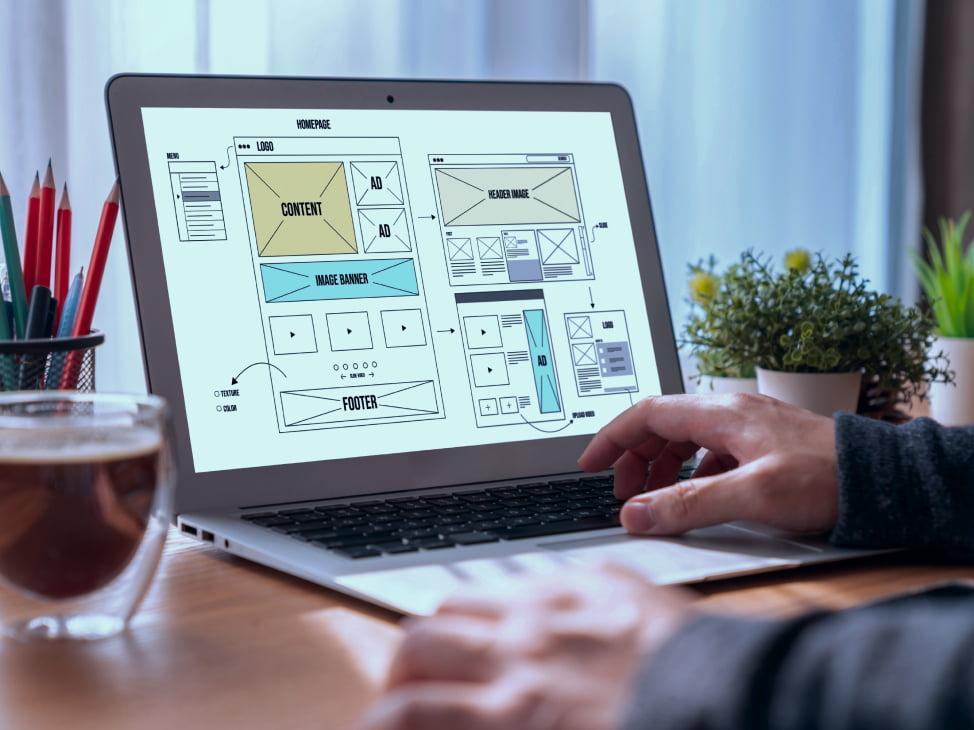
Your website's homepage is the digital equivalent of a storefront window. It's the first impression that convinces passersby to step inside. In today's web world, a well-designed homepage is crucial for success.
This website homepage design guide will delve into the essential elements that every effective homepage needs. It transforms it from a static brochure into a conversion machine. We'll explore how clear navigation guides visitors effortlessly. Meanwhile, we will captivate visuals, grab their attention, and communicate your brand identity.
We'll also discuss the power of persuasive calls to action, nudging visitors towards the desired action, and the importance of building trust with social proof.
With these elements, you can craft a homepage that not only boasts stunning aesthetics. It will also compel visitors to take action, transforming them into loyal clients.
What Elements Should Be on the Homepage of a Website
Your home page for the website is more than just an online brochure. It's the crucial first impression that entices visitors to explore further. Like a captivating storefront window display, a well-designed homepage is a magnet. It draws users in and convinces them to step inside. But what exactly makes a homepage effective?
This block dives deep into the essential ingredients, transforming a homepage from a static page into a powerful lead-generation machine.
A Compelling Value Proposition
Your homepage needs to answer the visitor's most pressing question: "Why should I care?":
- Focus on benefits, not features. Don't just list features when planning website homepage design. Explain how those features solve your target audience's problems or improve their lives.
- Keep it concise. Aim for a clear, easy-to-understand statement that can be grasped in seconds.
- Tailor it to your audience. Speak directly to your ideal client's needs and desires.
For example, instead of simply saying, "We offer web design services," say: "Craft a stunning website that attracts new clients and grows your business."
Clear and User-Friendly Navigation
Imagine walking into a store with no clear layout or signage. A confusing navigation system will leave visitors frustrated and likely to click away:
- Simple and intuitive. Navigation should be easy to understand and use. It must allow visitors to find what they need quickly.
- Logical structure. Organize your navigation bar with clear categories and subcategories. Mimic is the way people think and search for information when making a home page for a website.
- Accessibility. Ensure your navigation is accessible on all devices, including desktops, tablets, and smartphones.
High-Quality Visuals
Visuals are powerful tools for grabbing attention. They convey information quickly and build brand identity:
- Hero image or video. A captivating hero image or video sets the tone for your website and leaves a lasting impression. Choose visuals that are relevant to your brand and resonate with your TA.
- Consistent imagery. Use high-quality images and graphics throughout your homepage. They must maintain a cohesive visual style.
- Optimize for size and speed. As one of the homepage's best practices, ensure your images are optimized for web viewing. It's to avoid slowing down your website's loading time.
Strong Call to Action (CTA)
Your homepage should not be a passive experience. A clear call to action (CTA) tells visitors exactly what you want them to do next:
- Action-oriented. Use verbs that command attention and encourage action. They are "Download," "Learn More," or "Shop Now."
- Prominent placement. Position your CTA in a prominent location on your homepage. It must be where it's easily visible and cannot be missed.
- Clear benefit. It is what should be on the homepage of a website. Highlight the benefits users will receive by taking the desired action.
Building Trust with Social Proof
Social proof leverages the psychology of trust. By showcasing positive reviews, testimonials, or case studies, you show the value you deliver to real clients:
- Client testimonials. Include quotes from satisfied clients that highlight the positive impact.
- Logos of trusted partners. Display logos of well-known brands you've collaborated with to add credibility and authority.
- Trust badges. Consider incorporating trust badges for security certificates or industry accreditations. It's to reassure visitors about the legitimacy of your business.
Mobile Responsiveness
Ensuring your website is responsive and adapts to different screen sizes is crucial:
- Responsive design. Your website should adjust its layout and content automatically. It's to display on desktops, tablets, and smartphones.
- Easy mobile navigation. The navigation bar and CTAs should be easy to use on touchscreens.
- Fast loading times. Optimize your site for mobile browsing. It's to ensure fast loading times, preventing visitors from getting frustrated.
Best Practices for Website Homepage Design
Crafting a site homepage that converts visitors into loyal clients requires a strategy.
The best practices will help you create a website homepage that looks good and effectively captures attention. It will guide visitors towards action and foster long-term brand loyalty.
Prioritize User Experience (UX) for Clarity and Usability
Your homepage should be a welcoming and intuitive space. It must cater to your target audience's needs:
- Simplicity is key. Avoid overwhelming visitors with cluttered layouts or excessive information. Focus on clarity with a clean design and concise content.
- Focus on scannable website homepage content. People often skim online content. Use headings, subheadings, bullet points, and short paragraphs. It's to make your homepage easily scannable.
- Intuitive navigation. Ensure your navigation bar is clear, logically organized, and easy to understand. Aim for consistency with common website design conventions.
- Accessibility for all. Cater to a wider audience by making your homepage accessible for users with disabilities. It includes extra features. They have proper color contrast, alternative text for images, and keyboard navigation compatibility.
Leverage the Power of Storytelling to Connect with Visitors
People connect with stories. Use the power of storytelling within your website homepage design. It's to engage visitors on an emotional level:
- Craft a compelling narrative. Weave a story that resonates with your target audience's aspirations, challenges, or desires.
- Highlight your brand values. Showcase the values your company embodies and how they translate into real-world benefits.
- Focus on the "why" behind your business. Don't just explain what you do. Explain why you do it and the impact you aim to create.
Optimize for Speed and Performance to Avoid Frustration
Today's web users are impatient. A slow-loading website can lead to frustration and a high bounce rate:
- Image optimization. This is what should be on the homepage of a website in the first place. Optimize all images on your homepage to reduce file size without compromising quality. It ensures fast loading times.
- Minimize code bloat. Unnecessary code can slow down your website. Work with a developer to ensure your website's code is clean and efficient.
- Choose a reliable hosting provider. Invest in a reliable web hosting provider. It must handle your website traffic and ensure optimal performance.
- Test and monitor performance. Regularly test your website's loading speed. Use tools like Google PageSpeed Insights and address any performance issues promptly.
Integrate A/B Testing for Continuous Improvement
The best website design practices are constantly evolving. For this:
- Identify areas for testing. Start by pinpointing specific elements you'd like to test. They are headlines, CTAs, or layout variations.
- Develop variations. Create different versions (A and B) of the chosen element with slight modifications.
- Run the test. Present both versions to your website visitors. Track which performs better based on specific metrics like conversion or click-through rates.
- Learn and adapt. Analyze the results of your A/B tests. It's to identify what resonates with your audience. Also, continuously refine your home page for website design for optimal results.
Best SEO Practices for Home Page
Your website's homepage is prime real estate when it comes to SEO. By optimizing your homepage for relevant keywords and user experience, you can increase your website's visibility in search engine results pages (SERPs) and attract more organic traffic.
These best practices help you transform your website's homepage into a powerful SEO tool. It will attract organic traffic, improve brand visibility, and drive success. Here are the best SEO practices for your homepage.
Keyword Research and Strategic Implementation
Keywords are the words and phrases people use to search for information online:
- Identify relevant keywords. Utilize keyword research tools like Google Keyword Planner or SEMrush. It's to discover keywords with high search volume and low competition.
- Target a mix of keywords. Focus on a combination of broad and specific keywords. It's to capture a wider audience while also targeting users with high purchase intent.
- Strategic keyword placement. Integrate your target keywords naturally throughout your website homepage content. It includes the title tag, meta description, headings, and body copy. Avoid keyword stuffing, which can negatively impact your SEO ranking.
Craft Compelling Title Tags and Meta Descriptions
The title tag and meta description are snippets of text displayed on search engine results pages. They entice users to click on your website:
- Compelling title tag. Create a concise, keyword-rich title tag (ideally under 60 characters). It must accurately reflect your homepage content and entice users to click.
- Engaging meta description. Write an informative and engaging meta description (around 160 characters). It must summarize the value proposition of your website homepage content and compel users to learn more. Include a call to action to further encourage clicks.
Optimize On-page Content for Readability and User Engagement
High-quality, informative content is essential for both user experience and SEO:
- Create valuable content. Your homepage content should be informative and engaging and address your TA's pain points.
- Optimize content structure. Break up your content with headings, subheadings, bullet points, and short paragraphs. It's to improve readability and user engagement.
Leverage Internal Linking for Improved Website Navigation and SEO Value
Internal linking refers to the practice of linking to other relevant pages within your website:
- Strategic internal linking. Link to relevant and informative pages on your website from your homepage content. It helps search engines understand your website's structure and improves user navigation.
- Anchor text optimization. Use keywords in your anchor text, the clickable text of internal links. It helps search engines associate the linked page with those keywords.
- Create a clear linking hierarchy. Focus on linking to the most important pages on your website from your homepage. It creates a clear hierarchy for search engines and users alike.
Conclusion
Your website's homepage is the foundation of your online presence. Incorporate the elements and best practices outlined above. Then, you can craft a homepage that gets attention, guides visitors, and fosters loyalty.
Remember, a successful website homepage design is a user-centric experience. It must prioritize clarity, value proposition, and SEO optimization.
learn with mettevo
view blog


Are You Ready To Grow Your Website?
Understanding the ins and outs of website growth, we help ensure that your site grows over time with ever-increasing reach and accessibility. Not only do we employ the latest digital marketing techniques for driving traffic directly to your website, but our strategies also focus on gaining loyalty from those visitors so they come back again and again.
Leave your contacts to get a comprehensive and aggressive digital marketing plan taking your business to new heights.